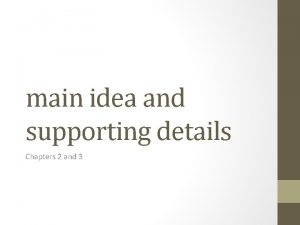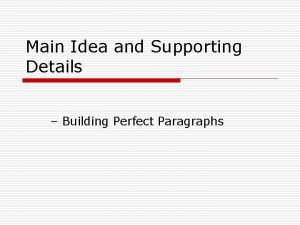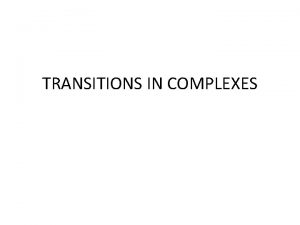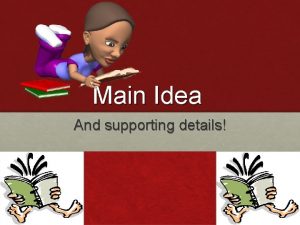Session 5 Main Points Supporting Points and Transitions





- Slides: 5

Session 5 Main Points Supporting Points and Transitions By Elanor J. Mc. Coy

Main Points • Start my identifying the central idea or theme of the speech • Each idea or theme should be expressed as a main point. • Main points should flow directly from your specific purpose and thesis statement (P 191) • 2 -5 main points can adequately discuss the material you want to convey. (P 192 -193) • State main points clearly and concisely • If the statement you make introduce a new or separate idea list them separately. (P 193) • Express your main points in declarative statements. • Emphasize the points and make them stand out.

Supporting points • In the outline supports appear in subordinate position to the main points. (195) • Main Points are enumerated with Roman Numerals. • 1 st level supporting points are enumerated with capital letters. • 2 nd level supports are enumerated with Arabic letters • 3 rd level supports are enumerated with lowercase letters

Principles to use when organizing main and supporting points • Unity – this type of principle is used when the main points consist only of the points implied in thesis statement. (191) – Each main point supports thesis statement. – Each supporting point provides evidence for the main point and so on. – Each main point focuses on a single idea. • Coherence – refers to the clarity and logical consistency – The speech body follows logically from the introduction. – The conclusion follows logically from the body. – Within the body the main points should logically follow thesis statement • Balance – suggest the appropriate emphasis and weight be given to each part of the speech. – Body is the longest part – The introduction and conclusion about the same in length.

Transitions • • • Enables the speaker to move smoothly from one point to another. The main purpose is to inform the audience when a new point is made and to keep their attention. There are 3 types of transitions – Full sentence (P 198 -199) – One word – Signpost (P (202) – Phrase - Signpost (P 202) Posing or stating transitions Restate, forecast form – restate the previous point made and review the next point to be covered. Rhetorical question – Internal preview and summaries as transitions Internal previews – used to tell the audience what to expect. In the introduction it tells what will be covered in the body of the speech Internal Summary – often used in the conclusion, it draws together important ideas before proceeding to another speech point. If used in the body they can help the listener review and evaluate common threads of theme.








